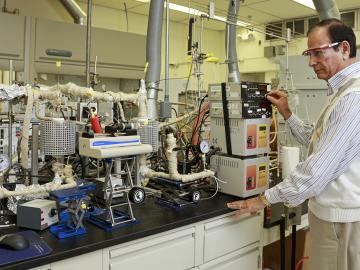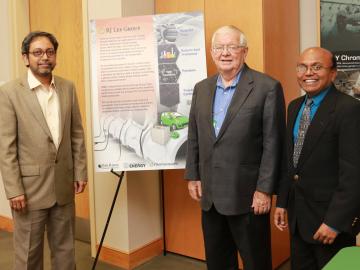
Filter News
Area of Research
- (-) Materials (89)
- (-) Supercomputing (58)
- Advanced Manufacturing (7)
- Biological Systems (3)
- Biology and Environment (17)
- Biology and Soft Matter (1)
- Building Technologies (2)
- Chemical and Engineering Materials (2)
- Chemistry and Physics at Interfaces (6)
- Clean Energy (110)
- Climate and Environmental Systems (2)
- Computational Chemistry (1)
- Computer Science (2)
- Energy Frontier Research Centers (7)
- Energy Sciences (1)
- Functional Materials for Energy (6)
- Fusion and Fission (5)
- Fusion Energy (6)
- Geographic Information Science and Technology (2)
- Isotope Development and Production (1)
- Isotopes (4)
- Materials for Computing (5)
- Materials Synthesis from Atoms to Systems (5)
- Materials Under Extremes (6)
- National Security (12)
- Neutron Data Analysis and Visualization (2)
- Neutron Science (37)
- Nuclear Science and Technology (28)
- Nuclear Systems Modeling, Simulation and Validation (2)
- Quantum Condensed Matter (2)
- Quantum information Science (3)
- Reactor Technology (1)
- Transportation Systems (2)
News Type
News Topics
- 3-D Printing/Advanced Manufacturing (6)
- Advanced Reactors (1)
- Artificial Intelligence (5)
- Big Data (8)
- Bioenergy (5)
- Biology (1)
- Biomedical (8)
- Chemical Sciences (2)
- Climate Change (1)
- Computer Science (29)
- Coronavirus (8)
- Critical Materials (3)
- Cybersecurity (1)
- Decarbonization (1)
- Energy Storage (8)
- Environment (7)
- Exascale Computing (2)
- Frontier (1)
- Fusion (1)
- Grid (2)
- High-Performance Computing (2)
- Isotopes (1)
- Machine Learning (4)
- Materials (2)
- Materials Science (31)
- Mathematics (1)
- Microscopy (5)
- Molten Salt (1)
- Nanotechnology (13)
- National Security (1)
- Neutron Science (15)
- Nuclear Energy (4)
- Physics (8)
- Polymers (4)
- Quantum Science (10)
- Security (1)
- Summit (13)
- Sustainable Energy (7)
- Transformational Challenge Reactor (2)
- Transportation (4)
Media Contacts

A new study from the Department of Energy’s Oak Ridge National Laboratory explains the mechanism behind a technology that converts bio-based ethanol into hydrocarbon blend-stocks for use as fossil fuel alternatives. Scientists have experimented for decades with a cl...






Engines, laptops and power plants generate waste heat. Thermoelectric materials, which convert temperature gradients to electricity and vice versa, can recover some of that heat and improve energy efficiency. A team of scientists at the Department of Energy’s Oak Ridg...

Quasiparticles—excitations that behave collectively like particles—are central to energy applications but can be difficult to detect. Recently, however, researchers have seen evidence of quasiparticles called negative trions forming and fading in a layer of semiconducting mate...




